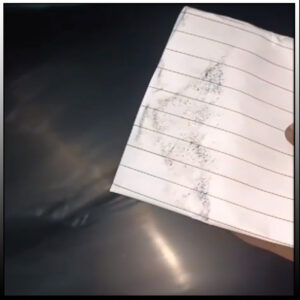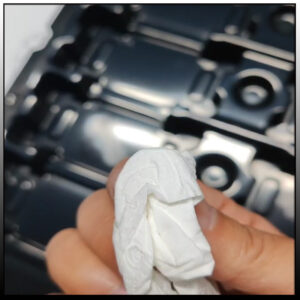The harm of carbon powder falling off in conductive plastics
Carbon powder falling off conductive plastics is mainly because the bonding between carbon powder and plastic matrix is not firm. Carbon powder falling off the surface of terminal products made of conductive plastics will affect product performance.
In terms of conductivity, carbon powder falling off will reduce or destroy the conductive path. Because carbon powder is the key component for conductive plastics to achieve conductive function, the surface resistivity of the product may increase and the conductive performance may decrease after the carbon powder falls off, thus affecting its function in application scenarios with high requirements for conductive performance such as anti-static packaging and electromagnetic shielding.

For appearance quality, carbon powder falling off will cause the surface of the product to appear mottled and uneven in color, affecting the aesthetics of conductive plastics. In some occasions with high requirements for appearance, such as electronic equipment housings, automotive interiors, etc., this situation is unacceptable.
In terms of mechanical properties, carbon powder falling off may make the surface of conductive plastic products rough and reduce the surface hardness. If the product is used in a friction environment, such as buttons, sliders, and other parts, it will accelerate its wear and shorten the service life of the product.
What are the measures to improve the issue of carbon powder falling off?
Optimization of raw materials
- Select carbon powder: Select carbon powder with uniform particle size, regular shape, smooth surface, and high purity to improve its bonding with the plastic matrix, reduce agglomeration, and thus reduce the possibility of powder loss.
- Select resin: Select a resin matrix with good compatibility with carbon powder, good fluidity, and high flexibility, such as some special thermoplastic resins or modified resins, which can better disperse and fix carbon powder.

Improvement of the compounding process
- Optimize equipment and parameters: Use advanced mixing equipment, such as planetary mixers, co-rotating twin-screw extruders, etc., and accurately control parameters such as mixing speed, time, and temperature to ensure that carbon powder is evenly dispersed in the resin.
- Add dispersant or coupling agent: Adding an appropriate amount of dispersant or coupling agent, such as silane coupling agent, titanate coupling agent, etc. during the mixing process can improve the interface bonding between carbon powder and resin, increase bonding strength, and reduce powder loss.
- Optimize conductive polycarbonate (PC): Select conductive agents with good compatibility and good dispersibility with the polycarbonate (PC) matrix, such as conductive carbon black, carbon nanotubes, graphene, etc. with special surface treatment. These conductive agents can form a stable conductive network in the polycarbonate (PC) matrix and reduce the possibility of carbon powder falling off. Select polycarbonate (PC) resin with narrow relative molecular weight distribution and low impurity content, which has a stronger binding force with the conductive agent, can improve the overall stability of the material and reduce carbon powder falling off. Conductive polycarbonate (PC) has stable conductive properties, and there is no carbon powder shedding in the molded products.
- Optimize conductive ABS: Select high-quality conductive carbon black and other fillers, and ensure that their particle size is appropriate. Smaller and more uniform particles can be better dispersed in the ABS matrix and are not easy to fall off. For example, nano-level conductive fillers have a strong binding force with ABS resin. The conductive filler can be surface-treated to enhance its compatibility with ABS resin. Use coupling agents and other additives for treatment, so that the filler and resin are closely combined to prevent the carbon powder from falling off the surface of the conductive ABS terminal product.
Optimization of the molding process
- Accurate control of molding parameters: Accurately control the molding temperature, pressure, and time to avoid excessive temperature causing carbon powder oxidation or resin degradation, which affects the bonding force; at the same time, ensure that the pressure and time are sufficient to fully integrate the carbon powder and the resin to ensure that the surface of the terminal product made of conductive plastic has good adhesion. For extruded conductive sheets and conductive films, molding temperature is an important factor.
- Optimize mold design: Design a reasonable mold structure, such as optimizing the shape, size, and layout of the flow channel, so that the plastic melt flows evenly in the mold, and avoids the aggregation or shedding of carbon powder due to local uneven flow.
Improve packaging and storage methods
In addition to the methods mentioned above, there are also the following measures to reduce the carbon powder falling off the surface of conductive plastics:
- Use sealed packaging: Package conductive plastic products in sealed plastic bags, aluminum foil bags, or plastic films to reduce contact with external air, moisture, and dust, and prevent carbon powder from falling off due to friction or collision.
- Reasonable placement and isolation: During storage and transportation, place conductive plastic products on stable and dry shelves or containers to avoid contact or collision with sharp and hard objects. Soft materials such as foam and sponge can be used for isolation and buffering.




